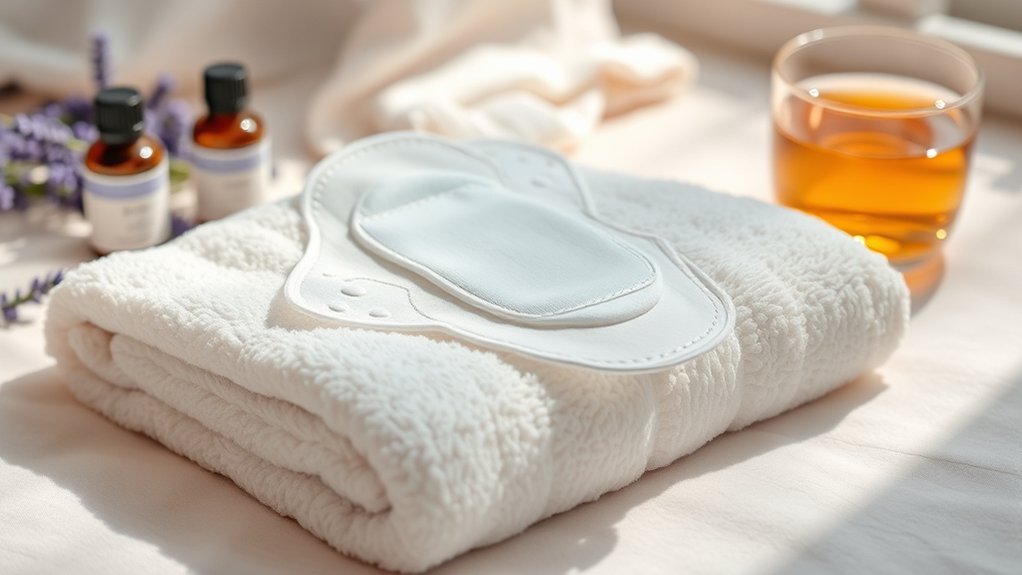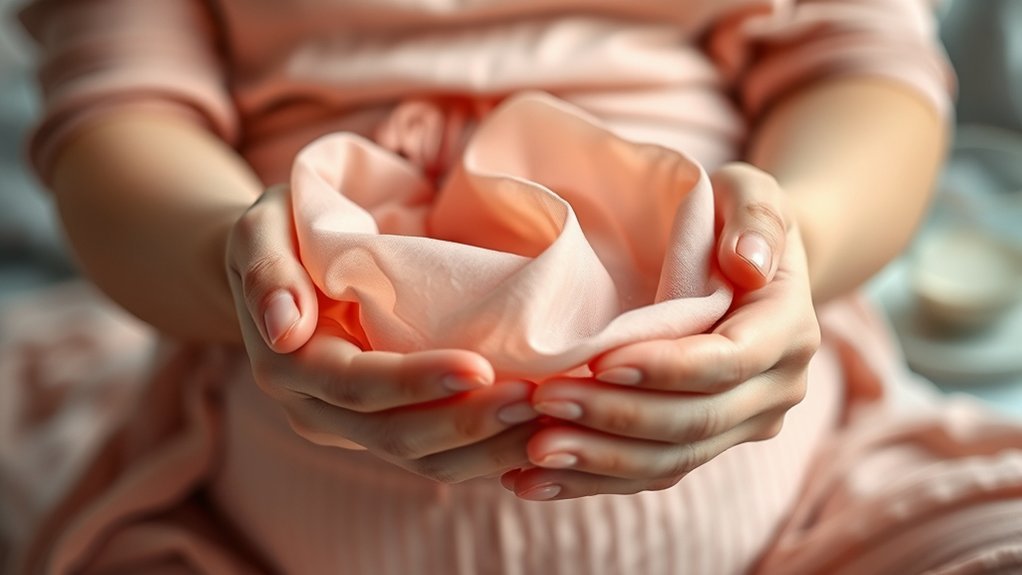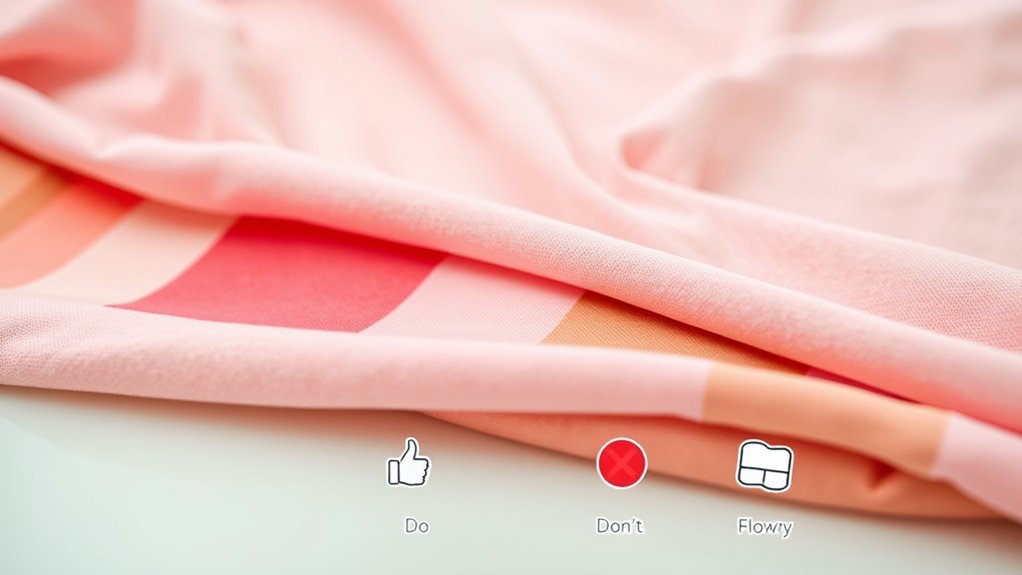After giving birth, understanding lochia is essential for your recovery. You’ll experience various stages of discharge that can impact your health. Knowing the do’s and don’ts during this time will help you manage your recovery effectively. For instance, using sanitary pads is important, but certain activities should be avoided. Let’s explore what you should prioritize and what to steer clear of to guarantee a smooth postpartum experience.
Understanding Lochia: What to Expect
When you give birth, your body undergoes significant changes, and one of the most crucial processes is the expulsion of lochia. This vaginal discharge is essential for your postpartum recovery, consisting of blood, mucus, and uterine tissue.
Lochia progresses through three stages: lochia rubra, characterized by dark red discharge lasting 3-4 days; lochia serosa, a pinkish-brown discharge lasting 4-12 days; and finally, lochia alba, a yellowish-white discharge that can last up to six weeks.
Lochia transitions through three stages: lochia rubra, serosa, and alba, each with distinct colors and durations.
Initially, expect heavy bleeding, which should gradually decrease in volume and change color. Monitor for excessive bleeding or large clots, as these may signal complications that require medical attention. Preeclampsia is a life-threatening disorder that can affect postpartum recovery, so it’s essential to be aware of any unusual symptoms.
Lochia should have a musty odor; any foul smell indicates potential infection.
The Stages of Lochia: A Breakdown
Lochia progresses through three distinct stages:
- Lochia Rubra: Dark or bright red discharge lasting 3-4 days, characterized by heavy flow and small clots.
- Lochia Serosa: Pinkish-brown discharge lasting 4-12 days, featuring a lighter flow with minimal clotting.
- Lochia Alba: Yellowish-white discharge lasting 2-6 weeks, where the flow is light and primarily consists of mucus with little or no blood.
Monitoring these stages of lochia is important. Additionally, understanding the importance of prenatal care can help you better prepare for the postpartum period and recognize any potential complications early on.
Be alert for warning signs like excessive postpartum bleeding or foul-smelling discharge, as these may indicate the need for medical attention during your postpartum recovery.
Do’s for Managing Lochia at Home
To effectively manage lochia at home, you should follow key practices that promote healing and comfort during your postpartum recovery.
Use sanitary maxi pads for the first six weeks, changing them frequently due to the heavy flow of lochia initially. Monitor the color and flow, noting its progression from dark red to pinkish-brown, and ultimately to yellowish-white, which indicates proper healing.
Avoid using tampons during this period to minimize the risk of infection in your recovering uterus. Wear clothing that you don’t mind staining, as lochia may leak.
Finally, prioritize rest and accept help from loved ones to support your recovery, ensuring you focus on your healing journey during this crucial time.
Don’ts During the Lochia Recovery Period

Managing lochia involves not only knowing what to do but also understanding what to avoid during your recovery period.
To guarantee a smooth healing process, keep these important don’ts in mind:
- Avoid tampons: Using them during the first six weeks can increase the risk of infection as your uterus heals.
- Do not engage in heavy physical activity: Lifting or strenuous exercise can exacerbate postpartum bleeding and delay healing.
- Refrain from baths or swimming: These activities can introduce bacteria into the vaginal canal until lochia has completely stopped.
- Don’t ignore signs of abnormal lochia: If you notice foul-smelling discharge, large clots, or excessive bleeding, contact your healthcare provider immediately.
Additionally, it’s important to discuss any concerns about maternal health conditions with your healthcare provider to ensure a safe recovery.
Remember to take it easy to promote a healthy recovery.
Monitoring Your Lochia: Signs of Abnormality
Monitoring your lochia is essential for guaranteeing a healthy recovery, especially in the first few weeks postpartum. Pay close attention to any signs of abnormality that may require medical attention. Here’s a quick reference table to help you identify concerning symptoms:
| Sign | What to Look For | Action Required |
|---|---|---|
| Heavy Bleeding | Soaking a maxi pad in less than an hour | Seek immediate medical attention |
| Large Clots | Clots the size of a golf ball or larger | Consult your healthcare provider |
| Foul-Smelling Discharge | Unpleasant odor from the discharge | Contact a healthcare provider |
| Persistent Symptoms | Fever, chills, or severe abdominal pain | Visit a healthcare professional |
| Lochia Color Change | No lightening in color or flow | Monitor closely and report issues |
Stay vigilant for these signs to guarantee your postpartum recovery remains on track.
When to Contact Your Healthcare Provider
It’s important to know when to reach out to your healthcare provider during your postpartum recovery.
Monitoring your lochia is essential, and you should contact your healthcare provider if you experience:
- Heavy bleeding that soaks through a maxi pad in less than an hour or lasts several hours.
- Large clots the size of a golf ball or larger, as this may indicate complications.
- Signs of infection, such as foul-smelling lochia, fever, chills, or abdominal tenderness.
- Sudden changes in discharge, like a return to heavy bleeding after it has lightened.
Additionally, if you experience severe abdominal pain or cramps not relieved by normal pain relief, seek medical attention promptly.
Prioritizing your postpartum care is crucial for your recovery.
Tips for Postpartum Self-Care

As you navigate the postpartum period, prioritizing self-care is vital for your recovery. Focus on getting adequate rest and don’t hesitate to ask loved ones for help.
To manage postpartum bleeding effectively, use super absorbent sanitary pads and change them frequently, avoiding tampons for at least six weeks to lower the risk of infection. Wear comfortable clothing that allows for easy changes, as lochia can lead to unexpected leaks.
Good hygiene is important; shower regularly and keep the vaginal area clean to prevent infections. Attend all postpartum checkups and communicate any concerns regarding your bleeding patterns to your healthcare provider for proper medical guidance. Additionally, consider enrolling in doula-led virtual prenatal education classes to empower yourself with knowledge during this healing phase.
Your comfort and health are paramount during this healing phase.
Frequently Asked Questions
What Makes Lochia Worse?
Overexertion, early sexual activity, using tampons, skipping postpartum checkups, and inadequate hydration or nutrition can all worsen lochia. These factors may increase bleeding and delay your body’s healing process after childbirth.
What Is the Hardest Day of Postpartum?
The hardest day of postpartum is typically around the 3rd to 5th day, when bleeding peaks and discomfort escalates. You’ll likely feel overwhelmed, but remember, this phase is temporary and support is essential.
What to Do During Lochia?
During lochia, use super absorbent pads, change them frequently, and monitor color and volume. Rest often, maintain good hygiene, and track any changes. Contact your provider if you notice foul odor, large clots, or excessive bleeding.
How to Know Lochia Is Over?
Most women notice lochia ceases around six weeks postpartum. You’ll know it’s over when the discharge changes to a light yellowish or whitish color and you haven’t experienced bleeding for several consecutive days.
Conclusion
In the journey of postpartum recovery, lochia symbolizes your body’s healing process, akin to a flower shedding its petals to bloom anew. By following the do’s and don’ts, you nurture this transformation, ensuring a smoother path to recovery. Stay vigilant for any signs of abnormality, and don’t hesitate to reach out to your healthcare provider if concerns arise. Prioritizing self-care during this delicate phase will allow you to embrace the beauty of motherhood with confidence and wellness.
